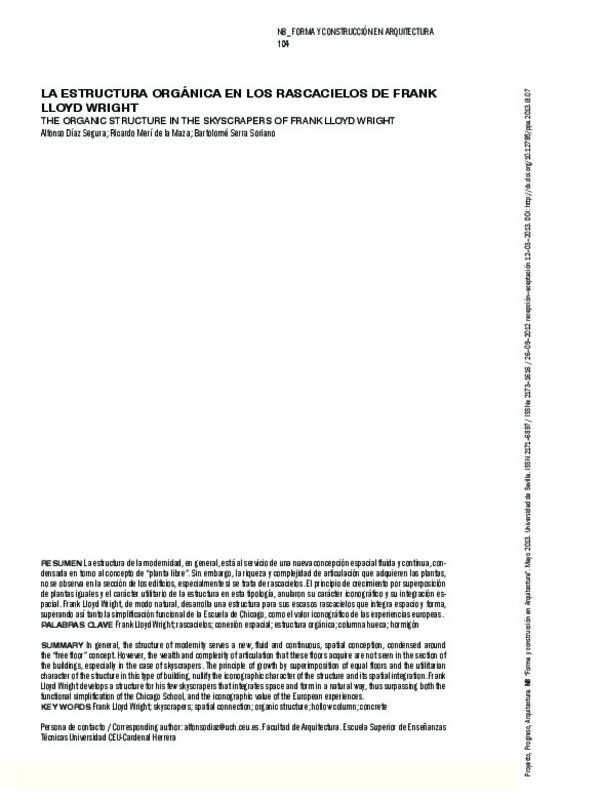JavaScript is disabled for your browser. Some features of this site may not work without it.
Buscar en RiuNet
Listar
Mi cuenta
Estadísticas
Ayuda RiuNet
Admin. UPV
La estructura orgánica en los rascacielos de Frank Lloyd Wright
Mostrar el registro sencillo del ítem
Ficheros en el ítem
| dc.contributor.author | DIAZ SEGURA, ALFONSO LUIS
|
es_ES |
| dc.contributor.author | Meri de la Maza, Ricardo
|
es_ES |
| dc.contributor.author | Serra Soriano, Bartolomé
|
es_ES |
| dc.date.accessioned | 2020-09-09T03:31:22Z | |
| dc.date.available | 2020-09-09T03:31:22Z | |
| dc.date.issued | 2013 | es_ES |
| dc.identifier.issn | 2171-6897 | es_ES |
| dc.identifier.uri | http://hdl.handle.net/10251/149636 | |
| dc.description.abstract | [ES] La estructura de la modernidad, en general, está al servicio de una nueva concepción espacial fluida y continua, condensada en torno al concepto de ¿planta libre¿. Sin embargo, la riqueza y complejidad de articulación que adquieren las plantas, no se observa en la sección de los edificios, especialmente si se trata de rascacielos. El principio de crecimiento por superposición de plantas iguales y el carácter utilitario de la estructura en esta tipología, anularon su carácter iconográfico y su integración espacial. Frank Lloyd Wright, de modo natural, desarrolla una estructura para sus escasos rascacielos que integra espacio y forma, superando así tanto la simplificación funcional de la Escuela de Chicago, como el valor iconográfico de las experiencias europeas. | es_ES |
| dc.description.abstract | [EN] In general, the structure of modernity serves a new, fluid and continuous, spatial conception, condensed around the ¿free floor¿ concept. However, the wealth and complexity of articulation that these floors acquire are not seen in the section of the buildings, especially in the case of skyscrapers. The principle of growth by superimposition of equal floors and the utilitarian character of the structure in this type of building, nullify the iconographic character of the structure and its spatial integration. Frank Lloyd Wright develops a structure for his few skyscrapers that integrates space and form in a natural way, thus surpassing both the functional simplification of the Chicago School, and the iconographic value of the European experiences. | es_ES |
| dc.language | Español | es_ES |
| dc.publisher | Editorial Universidad de Sevilla | es_ES |
| dc.relation.ispartof | Proyecto, Progreso, Arquitectura | es_ES |
| dc.rights | Reconocimiento - No comercial - Sin obra derivada (by-nc-nd) | es_ES |
| dc.subject | Frank Lloyd Wright | es_ES |
| dc.subject | Rascacielos | es_ES |
| dc.subject | Conexión espacial | es_ES |
| dc.subject | Estructura orgánica | es_ES |
| dc.subject | Columna hueca | es_ES |
| dc.subject | Hormigón | es_ES |
| dc.subject | Skyscrapers | es_ES |
| dc.subject | Spatial connection | es_ES |
| dc.subject | Organic structure | es_ES |
| dc.subject | Hollow column | es_ES |
| dc.subject | Concrete | es_ES |
| dc.subject.classification | PROYECTOS ARQUITECTONICOS | es_ES |
| dc.title | La estructura orgánica en los rascacielos de Frank Lloyd Wright | es_ES |
| dc.title.alternative | The organic structure in the skyscrapers of Frank Lloyd Wright | es_ES |
| dc.type | Artículo | es_ES |
| dc.identifier.doi | 10.12795/ppa.2013.i8.07 | es_ES |
| dc.rights.accessRights | Abierto | es_ES |
| dc.contributor.affiliation | Universitat Politècnica de València. Departamento de Proyectos Arquitectónicos - Departament de Projectes Arquitectònics | es_ES |
| dc.description.bibliographicCitation | Diaz Segura, AL.; Meri De La Maza, R.; Serra Soriano, B. (2013). La estructura orgánica en los rascacielos de Frank Lloyd Wright. Proyecto, Progreso, Arquitectura. (8):104-117. https://doi.org/10.12795/ppa.2013.i8.07 | es_ES |
| dc.description.accrualMethod | S | es_ES |
| dc.relation.publisherversion | https://doi.org/10.12795/ppa.2013.i8.07 | es_ES |
| dc.description.upvformatpinicio | 104 | es_ES |
| dc.description.upvformatpfin | 117 | es_ES |
| dc.type.version | info:eu-repo/semantics/publishedVersion | es_ES |
| dc.description.issue | 8 | es_ES |
| dc.relation.pasarela | S\335712 | es_ES |








